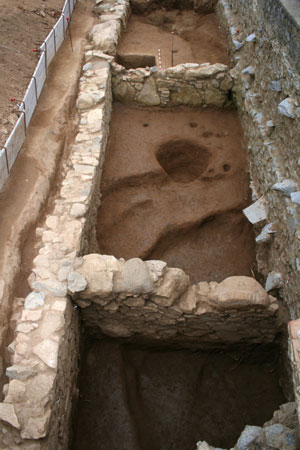 A number of different occupation levels have been
documented. The first structures — all exclusively
Iberian — show continuous occupation from the 2nd
c. B.C.E. onwards. The oldest element is a storage pit
which three post-holes are associated with. The pit was
cut through a number of geological strata and was
subsequently filled with gravel and silt that contained a
significant quantity of Iberian pottery. The oldest wall
— possibly belonging to structures that are not
preserved — stands on this leveled surface. During
the Ibero-Roman period (2nd – 1st c. B.C.E.), a
series of new buildings were attached to this wall
forming three areas that are still visible today. As in
the rest of the late Republican settlement, the walls are
of mud-brick set on a stone foundation; these were
discovered in a collapsed state during excavations. It is
difficult to say more about the various levels of
occupation or the function of these structures since they
are still being studied. Nonetheless, it appears that the
structures of the Ibero-Roman phase delimit the northern
edge of the settlement.
A number of different occupation levels have been
documented. The first structures — all exclusively
Iberian — show continuous occupation from the 2nd
c. B.C.E. onwards. The oldest element is a storage pit
which three post-holes are associated with. The pit was
cut through a number of geological strata and was
subsequently filled with gravel and silt that contained a
significant quantity of Iberian pottery. The oldest wall
— possibly belonging to structures that are not
preserved — stands on this leveled surface. During
the Ibero-Roman period (2nd – 1st c. B.C.E.), a
series of new buildings were attached to this wall
forming three areas that are still visible today. As in
the rest of the late Republican settlement, the walls are
of mud-brick set on a stone foundation; these were
discovered in a collapsed state during excavations. It is
difficult to say more about the various levels of
occupation or the function of these structures since they
are still being studied. Nonetheless, it appears that the
structures of the Ibero-Roman phase delimit the northern
edge of the settlement.
The content displayed on this page reproduces, with permission of the author and the journal, fragments of the following article: Sinner, A. G. “Cultural contacts and identity construction: a colonial context in NE Spain (2nd – early 1st c. B.C.),” Journal of Roman Archaeology 28 (2015) 7-37.